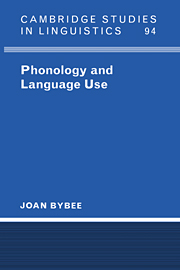Book contents
- Frontmatter
- Contents
- List of Figures
- List of Tables
- Acknowledgments
- 1 Language Use as Part of Linguistic Theory
- 2 A Usage-Based Model for Phonology and Morphology
- 3 The Nature of Lexical Representation
- 4 Phonological Processes, Phonological Patterns
- 5 The Interaction of Phonology with Morphology
- 6 The Units of Storage and Access: Morphemes, Words, and Phrases
- 7 Constructions as Processing Units: The Rise and Fall of French Liaison
- 8 Universals, Synchrony and Diachrony
- References
- Author Index
- Subject Index
- Languages Index
6 - The Units of Storage and Access: Morphemes, Words, and Phrases
Published online by Cambridge University Press: 03 December 2009
- Frontmatter
- Contents
- List of Figures
- List of Tables
- Acknowledgments
- 1 Language Use as Part of Linguistic Theory
- 2 A Usage-Based Model for Phonology and Morphology
- 3 The Nature of Lexical Representation
- 4 Phonological Processes, Phonological Patterns
- 5 The Interaction of Phonology with Morphology
- 6 The Units of Storage and Access: Morphemes, Words, and Phrases
- 7 Constructions as Processing Units: The Rise and Fall of French Liaison
- 8 Universals, Synchrony and Diachrony
- References
- Author Index
- Subject Index
- Languages Index
Summary
Introduction
In this chapter, I address the nature of the units of lexical storage and explore the phonological evidence for the manner of representation of morphemes, words, phrases, and constructions. The focus of this chapter is to demonstrate that the model of lexical representation presented in this book – in which words are represented in the lexicon as a range of phonetic variation – leads us to an explanation for the predominance of alternations within words rather than across word boundaries and helps us explain some of the properties of word boundaries, such as the tendency for a final word boundary to act like a consonant. Section 6.2 begins by exploring the phonological properties of words, using evidence from words that vary in context to motivate a hypothesis about the manner in which the diverse exemplars of individual words are organized and reorganized. Since alternations between variants of words tend to occur at word boundaries, we also explore the properties of word boundaries and explain why a final word boundary usually acts like a consonant. In Section 6.3, we examine the evidence from sound change in progress for the lexical connections made among different instances of word-internal morphemes. The importance of alternating versus nonalternating environments for the progress of a sound change is explored with respect to both words and morphemes.
The discussion then moves on to the representation of larger stretches of speech. In Section 6.4, I argue that frequent phrases and constructions behave like words phonologically, since phonological processes which are otherwise restricted to word-internal position apply internally to such chunks.
- Type
- Chapter
- Information
- Phonology and Language Use , pp. 137 - 166Publisher: Cambridge University PressPrint publication year: 2001

